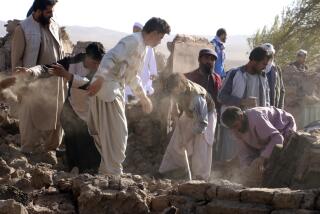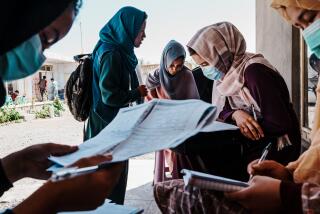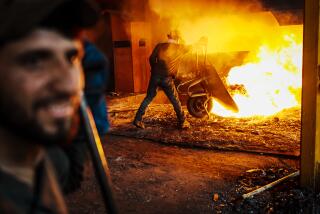For Afghans, Postwar Recovery Begins With Rebuilding Roads
- Share via
KABUL, Afghanistan — Under pressure for results from Afghanistan’s struggling government, foreign donors and international aid agencies are poised to undertake a massive road-rebuilding program that will provide a boost to the economy and some much-needed political capital to President Hamid Karzai.
The United States is taking on the biggest single piece of construction, the Kabul-Kandahar-Herat route, a $180-million project that will include the rebuilding of 10 bridges, Afghan government sources say. The European Union, the World Bank and the Asian Development Bank also will bankroll major road segments.
Afghanistan’s entire infrastructure, from water treatment systems and schools to electricity, is a shambles after 23 years of war. But Karzai has made reconstruction of the road system his top aid priority since taking office Dec. 22.
The roads are so awful that a 600-mile run on the route from Kabul to Herat, the main east-west corridor, takes truckers up to a week because of potholes, collapsed bridges and washouts.
Some foreign officials resisted the idea of dedicating so much aid money to highways, convinced that smaller projects such as fixing irrigation canals, cleaning up wells and rebuilding schools might actually bring more economic and social benefits faster.
“The Afghan government would like to see large-scale projects be built with enormously high political profiles [while] we want to improve the quality of people’s lives,” said one top foreign official who did not want his name or that of his government used.
International donors are far behind in delivering aid they have pledged. Of $1.8 billion promised for this year at an aid conference in Tokyo in January, $1.2 billion is outstanding.
Moreover, Afghan refugees have returned in unexpectedly high numbers. The return of 1.5 million people has forced the diversion of reconstruction funds to urgent needs such as providing food, shelter and medicine.
But now, with pressure mounting on Karzai to deliver results, Afghanistan’s foreign benefactors are coming around.
Reconstruction of five major trunk roads costing hundreds of millions of dollars will soon be announced. Work will begin as money is appropriated.
Officials say funds for the U.S. portion are expected sometime before Christmas.
“We sympathize with the need of the transition government to show visible progress,” the foreign official said.
“The level of destruction here exceeds anything I’ve ever seen,” the official said. “We’ve got to get moving.”
Iran’s government was the first to announce that it was underwriting a major road project, the 80-mile stretch from Herat to the Iranian border, perhaps shaming others into following suit.
Afghans have grown impatient with the slow pace of reform in the months following the removal of the Taliban regime.
Karzai and aid agencies have cautioned that reconstruction will take 10 to 15 years.
But road repairs cannot come soon enough for Ajamel, 24.
On Monday, he was wrung out after finally arriving in Kabul, the capital, with a load of Chinese fabric from Herat.
He was furious at the government, claiming that his work was easier under the Taliban.
Other drivers also waiting at the Kabul customs depot said they were angry not only about the bad roads but also about the lack of security.
Trucks are routinely stopped by armed men who shake down drivers for cash before allowing them to proceed.
“At least you only had to pay one toll and they worked on the roads,” Ajamel said of the Taliban. “Now we pay eight different bandits along the way 10 times as much and the roads only get worse.”
“The Americans promised they would make the government bring peace, but they are asleep now,” he said.
Another driver, Seddiquallah, 19, also arrived Monday from Herat and said the trip had become an ordeal.
“The potholes are so deep that the truck nearly tipped over in several places,” he said. “And I still got stopped at eight checkpoints by people who said they were in charge of local security. They say they are with the government, but they take money for personal benefit.”
The decision to proceed with the roadwork came after much debate among donor nations and international agencies about where to deploy their limited resources.
“In a country where there are so many problems, making priorities is difficult,” Lakhdar Brahimi, chief of the United Nations mission in Afghanistan, said at a news conference Tuesday.
An estimated 80% of Afghan school buildings are destroyed, only one-fifth of the capital’s population has piped water, and as few as 150,000 homes and businesses in a country of 26 million people have electric power.
But the economic costs of a road system in ruins may have persuaded the donors to adopt Karzai’s priority. Roads have deteriorated to the point that transportation costs per ton in Afghanistan can be eight times those of neighboring Pakistan.
Project sponsors will insist that Afghan public works officials operate in a totally new way, putting the projects out for competitive bid while investing a minimum in government-owned equipment.
Also, the international donors are insisting on a system of taxes and tolls to ensure that the roads are maintained, sources said.
Afghans will actually build the roads. The international agencies and foreign governments will pay for construction and closely monitor it to control costs.
The road building itself is expected to generate an enormous economic and social benefit by putting thousands of Afghans to work.
And if, as expected, many militia members take jobs on the road crews, the projects could have the added benefit of disarming parts of Afghanistan. Many serve under regional warlords because they have no other means of subsistence.
Good roads would also make Afghanistan’s economy much more efficient by reducing the time and cost of transportation. Afghanistan’s child mortality rate, which is very high, might fall because mothers in rural areas would have easier access to medical centers.
The World Bank’s country manager for Afghanistan, William Byrd, said Afghanistan needs so much help that it is hard to choose where to start. But as deep a hole as Afghanistan is in, other countries have recovered from similar adversity.
“South Korea in 1960 still looked like a poor prospect, and look what it’s done. It’s a high-technology center. The government got into a crash program to increase exports and promote education and is now prospering,” Byrd said.
“Afghans are energetic and entrepreneurial. We shouldn’t be discouraged,” Byrd said.
Faizullah Muktaj, an editor at the government-owned Kabul-based newspaper Anis, warned that new roads won’t bring about economic recovery unless the government is able to bring security to lawless roads and cities.
“There are still 2 million armed men around, and as long as there is no security or stable situation, reconstruction work will not be effective for the people and the Americans will fail,” Muktaj said.
More to Read
Sign up for Essential California
The most important California stories and recommendations in your inbox every morning.
You may occasionally receive promotional content from the Los Angeles Times.










